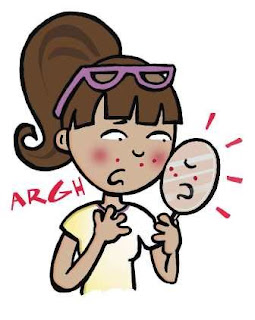Acne comes in many forms, as can be seen in the kinds of conditions that can be classified under acne. Three common kinds of acne are: acne vulgaris, acne folliculitis, and acne rosacea. The causes behind these conditions are many and varied but they might all result into zits, papules, nodules, and an oily complexion.
The first type, acne vulgaris, is very common among teens. This condition coincides with the hormonal changes happening inside a teen's body and results into the usual zits and breakouts that sprout just before an exam or a date. Since this condition can be seen in areas jam-packed with hair follicles and oil glands, zits usually grow on the neck, chest, arms, and face.
Acne vulgaris can then be divided into further subtypes, depending on its severity. A mild kind of acne vulgaris can be distinguished through the existence of blackheads and whiteheads. Along with the comedones are pustules and papules – inflamed pores with a whitish top (commonly known as a pimple or zit).
A severe kind usually involves painful cysts and nodules. These types are the ones that could usually result into scars and lesions when not treated properly. Squeezing cysts and nodules is therefore asking for more trouble.
The second type of acne is folliculitis. This skin condition is commonly caused by bacteria and when you have this kind of condition, zits are more likely to appear on your legs, chest, face, and other areas that could have been affected by friction induced by a tight-fitting outfit or a skin injury such as ingrown hairs. A rare kind of folliculitis is the one caused by fungi. This rare condition could be due to exposure to water contaminated by the fungi.
Usually mistaken as acne vulgaris, acne rosacea is another common kind. In this condition, adults who are more than 30 years old are the common victims, resulting into reddish cheeks, forehead, and nose. The reddening of the said areas are usually induced by spicy dishes, hot drinks, and exposure to UV rays. Aside from the redness of the affected area, pimples also emerge, and the inflamed nose could lead to rhinophyma (severe inflammation or external swelling of a nose, making it “bulbous”).
The culprits behind these kinds of acne are varied so the appropriate treatment for each kind is also different. Here is a list of some common treatments for these kinds of condition:
Topical medications – These include OTC treatments like benzoyl peroxide and salicylic acid.
Accutane – This medication has severe side effects so this is only used for zits that are immune to OTC and some prescription drugs.
Dermatologist-based treatments – Take note that the pimple-popping kind that might not cause more infection is usually done by a dermatologist. He uses a special and sterilized tool to prick your zits and applies an antibiotic or a disinfectant to prevent further infection.
Antibiotics – These drugs might have side effects so a prescription from an expert is needed.
Contraceptives – These are usually used when treating hormone-related acne.
Kat Daez writes for Intelligraph Corporation, an online media company. She currently writes articles about different causes of acne and various acne medications.
If you want to read more information about how to get rid of acne check out http://www.acnerecovery.com
Information on acne, acne treatment reviews, and treatment of scars

The Many Types Of Acne - Acne Vulgaris, Acne Folliculitis, And Acne Rosacea
Subscribe to:
Post Comments (Atom)
Blog Archive
-
▼
2008 (75)
-
▼
July (6)
- Acne - Secret Get Rid Of Acne Tips? - No! An Acne ...
- Acne - Tired Of Paying Loads On Crappy Acne Gels? ...
- Acne Home Remedy Cures For Acne Vulgaris - Get Rid...
- Acne Cleanser, Acne Lotion and More – a Quick Look...
- Acne Solution - The Only Top Acne Treatments That ...
- The Many Types Of Acne - Acne Vulgaris, Acne Folli...
-
▼
July (6)
0 comments:
Post a Comment